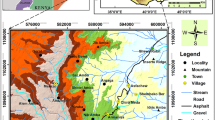Abstract
An extraordinarily large-scale landslide with a volume of about 200 million m3, a width of about 1,600 m, and a height of about 750 m occurred on 2004 March 26, 13:45 local time, on a steep caldera wall on the northwest flank of Mt. Bawakaraeng (2,830 m) at the headwater of the Jeneberang River in South Sulawesi, Indonesia. The debris avalanche extended about 7 km from the headwater and buried the river valley, causing devastating damage. There are a great many calderas in the world, notably Japan. If a large-scale sector collapse were to occur in a heavily populated area, it would be a devastating disaster for the people living in the area. The aim of this paper is to outline such a landslide and explain its mechanism of occurrence. We evaluated the stability of the original slope before the landslide using the limit equilibrium method and the finite-element-based shear strength reduction method (SSRFEM) with the strength reduction factor. The limit equilibrium method showed that a rise in the groundwater level caused the landslide. Although the critical slip surface predicted by the SSRFEM was shallower than that of the actual slip surface, the end positions of the actual and predicted slip surfaces were almost the same. Moreover, the end position of the critical slip surface before the landslide—the headwater of the Jeneberang River—was a knick point at which the slope inclination became steeper. SSRFEM analysis may be useful for evaluating the slope stability of large-scale landslides, because the critical slip surface predicted by it was close to the actual surface, even though we assumed homogenous conditions without information on the degree of weathering or ground properties. As the knick point formed at the end of the critical slip surface and is equivalent to the end of the actual slip surface, we assume such topographic features to be a primary geomorphologic cause of the landslide.









Similar content being viewed by others
References
Brückl E, Parotidis M (2005) Prediction of slope instabilities due to deep-seated gravitational creep. Nat Hazards Earth Syst Sci 5:155–172
Dan RS, Supriatna S (1982) Geologic map of the Ujungpandang, Benteg and SinJai Quadrangles, Sulawesi. Geological Research and Development Centre, Bandung
Griffiths DV, Lane PA (1999) Slope stability analysis by finite elements. Géotechnique 49(3):387–403
Gudmundsson A (1988) Formation of collapse calderas. Geology 16:808–810
Hoek E (1983) Strength of jointed rock masses, 23rd Rankine Lecture. Géotechnique 33(3):187–223
Hürlimann M, Ledesma A, Martj J (1999) Conditions favoring catastrophic landslide on Tenerife (Canary Islands). Terra Nova 11(2/3):106–111
Japan Geotechnical Society (2003) Use of the elasto-plastic finite element method. Japan Geotechnical Society, Tokyo, p 314
Japan Landslide Society (2006) Landslide analysis by finite element method. SANKAIDO, Tokyo, p 131
Japan Society of Civil Engineers (1999) Site investigation and stabilization methods for rock slopes. Japan Society of Civil Engineers, Tokyo, p 124
Karaston D, Thouret JC, Moriya I, Lomoschitz A (1999) Erosion calderas: origins, structural and climatic control. Bull Volcanol 61:174–193
Lambe TW, Whitman RV (1969) Soil mechanics. Wiley, New York, p 553
Masson DG, Watts AB, Gee MJR, Urgels R, Mitchell NC, Le Bas TP, Canals M (2000) Slope failures on the flanks of the western Canary Islands. Earth Sci Rev 57:1–35
Matsui T, San KC (1992) Finite element slope stability analysis by shear strength reduction technique. Soil Found 32(1):59–70
Moon V, Simpson CJ (2002) Large-scale mass wasting in ancient volcanic materials. Eng Geol 64:41–64
Rocscience Inc. (2002) Application of the finite element method to slope stability. Rocscience, Toronto, p 57
Saito K, Katahira H (1983) Some consideration on measured value from in-situ rock test of dam foundation. Technical note No. 1899, Public Works Research Institute, Ministry of Construction, Japan, p 78
Siebert L (1992) Threats from debris avalanches. Nature 356(23):658–659
Tsuchiya S, Koga S, Sasahara K, Matsui M, Nakahiro M, Watanabe H, Shima H, Yoshida K (2004) Reconnaissance of the gigantic landslide occurred on Mt. Bawakaraeng in the south Sulawesi state of Indonesia and unstable debris sedimentation (prompt report). J Jpn Soc Eros Control Eng 57(3):40–46
Ugai K (1989) A method of calculation of total safety factor of slope by elasto-plastic FEM. Soil Found 29(2):190–195
Ugai K, Leshchinsky D (1995) Three-dimensional limit equilibrium and finite element analysis: a comparison of results. Soil Found 35(4):1–7
van Leeuwen ThM (1981) The geology of south Sulawesi with special reference to the Biru area. In: Barber AJ, Wiryosujono S (eds) The Geology and Tectonics of Eastern Indonesia. Geological Research and Development Centre Special Publication 2, Bandung, pp 277–304
Zienkiewicz OC, Humpheerson C, Lewis RW (1975) Associated and non-associated visco-plasticity and plasticity in soil mechanics. Géotechnique 25(4):671–689
Acknowledgements
We conducted the site investigation as a JICA Sabo urgent investigation during 2004 June 20 to 29. We would like to acknowledge JICA (Japan International Corporation Agency) for providing us with this opportunity, and are grateful for the cooperation and help extended to us by the NGO, Komunitas Sabo. In particular, we would like to thank Dr. Agnes (Hasunudin University, Makassar) for assistance in the site investigation. This study was supported by a grant-in-aid for research from the Ministry of Education, Culture, Sports, Science and Technology of Japan (Project No. 1740503).
Author information
Authors and Affiliations
Corresponding author
Rights and permissions
About this article
Cite this article
Tsuchiya, S., Sasahara, K., Shuin, S. et al. The large-scale landslide on the flank of caldera in South Sulawesi, Indonesia. Landslides 6, 83–88 (2009). https://doi.org/10.1007/s10346-009-0143-x
Received:
Accepted:
Published:
Issue Date:
DOI: https://doi.org/10.1007/s10346-009-0143-x




